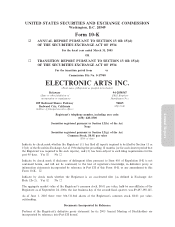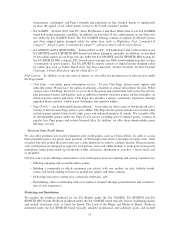Electronic Arts 2005 Annual Report Download - page 63
Download and view the complete annual report
Please find page 63 of the 2005 Electronic Arts annual report below. You can navigate through the pages in the report by either clicking on the pages listed below, or by using the keyword search tool below to find specific information within the annual report.
Online Games
To date, we have had limited success in Ñnding ways of generating revenue and proÑts from online games,
including subscription fees, ""pay-to-play fees'', micro transactions and advertising. In addition, we have had
limited experience with developing optimal pricing strategies or predicting usage patterns for our online
games. In our history, we have launched Ñve persistent state world products with mixed results. While we have
achieved success with Ultima Online, our other persistent state world products, most notably The Sims Online,
have not met our expectations.
In Ñscal 2004, we launched Club Pogo
TM
, a subscription service for Pogo, oÅering exclusive games and
premium features. We have over 800,000 paying subscribers as of March 31, 2005 up from 308,000 paying
subscribers as of March 31, 2004.
Despite our limited success to date, we believe that online capability is integral to our existing and future
products. The continued growth of the online sector of our industry will depend on the following key factors:
‚ Growing interest in multiplayer games,
‚ Willingness by consumers to pay for online game content,
‚ Rapid innovation of new online entertainment experiences,
‚ Mass market adoption of broadband technologies,
‚ Convergence of online capabilities in next-generation consoles, and
‚ Ability to create online products that are applicable in diverse global markets.
Next-Generation Consoles
During the next 18 months, we expect the next-generation of consoles to be released by Microsoft, Sony and
Nintendo. Our early investment in products designed for play on 32 and 128-bit consoles, such as the
PlayStation and PlayStation 2, respectively, has been strategically important in positioning us for the next-
generation of consoles. We believe that such investment continues to be important as the next-generation of
consoles is expected to introduce new complexities such as Blu-ray Disk-Read Only Memory (""BD-ROM'')
and/or High-DeÑnition video technologies. As we move through the life cycle of current-generation consoles,
we will continue to devote resources to developing games for these consoles, while at the same time increasing
our investment in tools and technologies for the next-generation of consoles.
Competition
Annual Report
We compete in the entertainment industry. At the most fundamental level, our products compete with other
forms of entertainment, such as motion pictures, television and music, for the leisure time and discretionary
spending of consumers. We believe that the software games segment is best viewed as a segment of the overall
entertainment market. We believe that large software companies and media companies are increasing their
focus on the software games segment of the entertainment market and as a result, may become more direct
competitors. Several large software companies and media companies (e.g., Microsoft and Sony) have been
publishing products that compete with ours for a long time, and other diversiÑed media/entertainment
companies (e.g., Time Warner and Disney) have announced their intent to signiÑcantly expand their software
game publishing eÅorts in the future.
The software games business is highly competitive. It is characterized by the continuous introduction of new
titles and the development of new technologies. Our competitors vary in size from very small companies with
limited resources to very large, diversiÑed corporations with greater Ñnancial and marketing resources than
ours. Our business is driven by hit titles, which require ever-increasing budgets for development and
marketing. As a result, the availability of signiÑcant Ñnancial resources has become a major competitive factor
in developing and marketing software games. Competition is also based on product quality and features,
timing of product releases, brand-name recognition, quality of in-game content, access to distribution
channels, eÅectiveness of marketing and price.
7
























